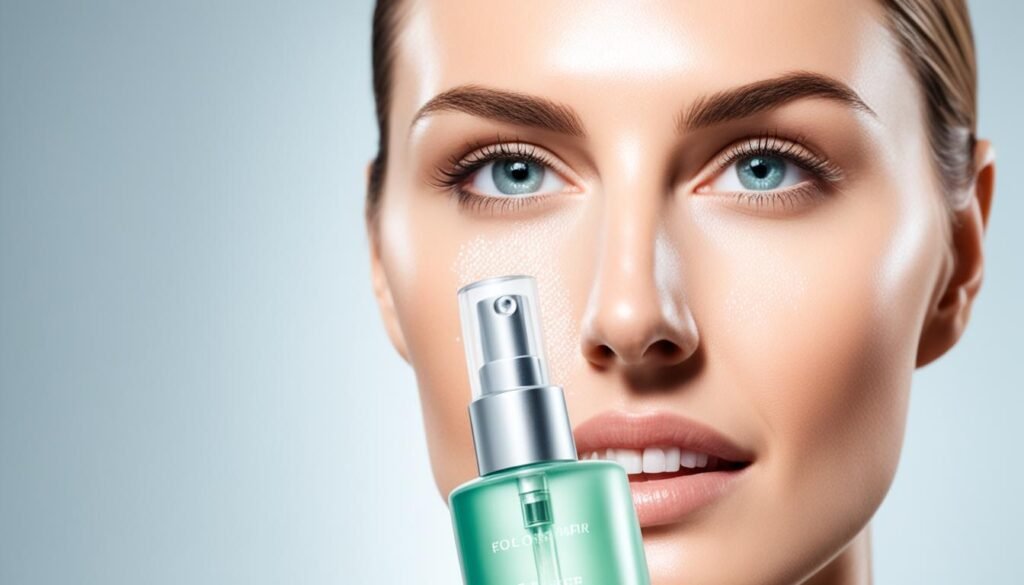Skin Care Routine For Dry Skin is a common skin condition that lacks sufficient moisture, often leading to a dull, rough, and flaky complexion with more visible fine lines. It can also feel tight, itchy, and uncomfortable. To help relieve these symptoms of dryness, it’s crucial to follow a consistent, hydrating skin care routine that includes gentle cleansing, toning, applying a hydrating serum, moisturizing, and protecting the skin with sunscreen.
Key Takeaways
- Dry skin lacks essential moisture and oils, leading to a disrupted skin barrier.
- A hydrating skin care routine is crucial to address the unique needs of dry skin.
- Gentle cleansing, toning, serums, moisturizing, and sun protection are key steps.
- Choosing the right products for your dry skin type is important.
- Incorporating additional tips, like exfoliation and managing flare-ups, can further improve skin health.
Understanding Dry Skin
Dry skin is a common skin condition that affects individuals of all skin types. It is characterized by a lack of moisture and oil in the skin, leading to a variety of unpleasant symptoms. Understanding the causes and signs of dry skin is essential in developing an effective skin care routine to combat this prevalent issue.
Causes of Dry Skin
Dry skin can be caused by a variety of factors, including environmental conditions, lifestyle choices, and underlying medical conditions. Factors such as cold, dry air, harsh cleansers, and excessive sun exposure can all contribute to the dehydration and disruption of the skin’s natural skin barrier. Additionally, certain medical conditions, such as eczema or thyroid disorders, can also lead to dehydrated skin.
Another common cause of dry skin is the natural aging process. As we grow older, our skin’s ability to retain moisture and produce natural oils diminishes, leading to the characteristic signs of dry skin types. This can be exacerbated by factors like frequent hand washing, long hot showers, and use of harsh skin care products that strip the skin of its natural oils.
Signs and Symptoms of Dry Skin
Individuals with dry skin often experience a range of unpleasant symptoms, including tightness, flakiness, and itchiness. The skin may appear dull, rough, and lacking in radiance, with more visible fine lines and wrinkles. In severe cases, dry skin can lead to cracking, peeling, and even bleeding, which can be uncomfortable and increase the risk of infection.
Furthermore, dry skin is often more prone to irritation and sensitivity, as the disrupted skin barrier makes it less effective at protecting the skin from environmental stressors. This can lead to a cycle of dryness, irritation, and further damage to the skin.
Importance of a Hydrating Routine

Maintaining a consistent, hydrating skin care routine is essential for individuals with dry skin. As the sources explain, dry skin lacks sufficient moisture and natural oils, which can lead to a disrupted skin barrier and various uncomfortable symptoms like tightness, flakiness, and irritation. By prioritizing hydration in your daily skin care regimen, you can help keep your skin hydrated and restore its healthy, radiant appearance.
A comprehensive, hydrating skin care routine typically involves gentle cleansing, toning, applying a nourishing serum, followed by a moisturizer formulated for dry skin. This multi-step approach works to hydrate the skin, replenish its natural oils, and strengthen the skin’s protective barrier, ultimately helping to hydrate dry skin and alleviate the common issues associated with dryness.
By incorporating these hydrating steps into your daily regimen, you can not only hydrate your skin but also enhance its overall skin hydration and resilience, leaving it feeling soft, supple, and radiant. Investing in a hydrating skin care routine is a valuable investment in the long-term health and hydrated skin you deserve.
Step 1: Gentle Cleansing

The first step in a hydrating skin care routine for dry skin is gentle cleansing. According to the sources, using the right cleanser is crucial for individuals with dry skin, as harsh or stripping cleansers can further disrupt the skin’s natural moisture balance.
Choosing the Right Cleanser
When it comes to cleansing your skin, it’s important to choose a cleanser for dry skin that is gentle, non-irritating, and won’t strip the skin of its natural oils. Look for cleansers that are free of harsh detergents, alcohols, and fragrances, which can strip your skin and strip moisture from your skin. Instead, opt for cleansers with nourishing, hydrating ingredients like ceramides, glycerin, and hyaluronic acid to cleanse your skin without stripping your skin.
Cleansing Techniques for Dry Skin
When it comes to cleansing techniques for dry skin, it’s important to be gentle and avoid over-cleansing. Gently wash your face with lukewarm water, and use your fingertips to cleanse your skin in circular motions. Avoid using washcloths or other abrasive materials, as they can irritate and strip the skin. After cleansing, be sure to pat your skin dry with a soft towel, rather than rubbing, to prevent further dehydration.
Step 2: Hydrating Toner

After thoroughly cleansing the skin, the next crucial step in a hydrating routine for dry skin is incorporating a hydrating toner. These specialized toners play a vital role in restoring the skin’s optimal pH balance and providing an additional layer of much-needed hydration.
Benefits of a Hydrating Toner
Hydrating toners offer a range of benefits for dry skin types. They help restore the skin’s pH, which can become disrupted due to factors like harsh cleansers or environmental stressors. By reestablishing the skin’s natural pH, hydrating toners can calm the skin and prepare it to better absorb subsequent skincare products. Moreover, these toners provide an extra boost of hydration, helping to quench parched skin and prevent it from feeling tight or uncomfortable.
Ingredients to Look for in Toners
When selecting a hydrating toner, look for formulas that contain skin-nourishing ingredients like glycerin, hyaluronic acid, aloe vera, and rosewater. These components work to replenish moisture and restore the skin’s barrier function. Avoid toners that contain alcohol, as this can further strip the skin of its natural oils and exacerbate dryness.
Step 3: Replenishing Serum

The third step in a hydrating skin care routine for dry skin is applying a replenishing serum. Serums are formulated with highly concentrated active ingredients that can target specific skin concerns, such as dehydration.
Hyaluronic Acid Serums
One of the most effective ingredients for boosting skin hydration is hyaluronic acid. This powerful humectant can draw moisture into the skin, plumping and smoothing the appearance of fine lines and wrinkles. Hyaluronic acid serums are an excellent choice for hydrating serum to include in a dry skin care routine.
Other Beneficial Serum Ingredients
In addition to hyaluronic acid, there are other beneficial serum ingredients that can address the unique needs of dry skin. These include ceramides to reinforce the skin barrier, glycerin to attract and retain moisture, and niacinamide to target specific skin concerns like uneven texture or dullness. Incorporating a replenishing serum with a blend of these active ingredients can provide comprehensive hydration and nourishment for dry, dehydrated complexions.
Step 4: Moisturizing

Moisturizing is a crucial step in a hydrating skin care routine for dry skin. The sources emphasize that applying the right moisturizer can help lock in moisture and provide long-lasting hydration to keep your skin feeling soft, supple, and improve skin health.
Choosing the Right Moisturizer
When it comes to moisturizer for dry skin, it’s important to choose a formula that is specifically designed to treat dry skin. Look for moisturizers that are creamy, rich, and contain nourishing ingredients for dry skin moisturizers like ceramides, glycerin, and shea butter. These ingredients help to lock in moisture and keep your skin feeling comfortable and hydrated.
Ingredients for Dry Skin Moisturizers
In addition to ceramides, glycerin, and shea butter, other beneficial ingredients for dry skin moisturizers include hyaluronic acid, omega-3 and omega-6 fatty acids, and plant-based oils like jojoba or argan oil. These ingredients work to moisturize, nourish, and improve skin barrier function, helping to lock in moisture and prevent future dryness.
Application Techniques
When applying your moisturizer for dry skin, be sure to massage it gently into the skin using upward, circular motions. This helps to lock in moisture and ensures the moisturizer is evenly distributed. It’s also important to apply your moisturizer to slightly damp skin to help keep your skin hydrated and improve skin absorption.
Step 5: Sun Protection

The final step in a hydrating skin care routine for dry skin is sun protection. Applying a broad-spectrum sunscreen is crucial for individuals with dry skin, as the sources explain that unprotected UV exposure can contribute to further dryness, damage, and premature aging.
Importance of Sunscreen for Dry Skin
While sun exposure is essential for vitamin D production, it can also have detrimental effects on dry skin. Sunscreen helps protect the skin from harmful UV rays, preventing further dehydration and damage that can lead to premature wrinkles, age spots, and other signs of skin aging. By incorporating a daily sunscreen into your routine, you can help maintain the skin’s barrier function and preserve its natural moisture levels.
Choosing the Right Sunscreen
When selecting a sunscreen for dry skin, look for formulas that are broad-spectrum, meaning they protect against both UVA and UVB rays. Choose a sunscreen with an SPF of 30 or higher to ensure adequate sun protection. Additionally, opt for moisturizing and non-comedogenic sunscreens that won’t clog your pores or further dry out your skin. Mineral-based sunscreens containing zinc oxide or titanium dioxide can be a good choice for dry, sensitive skin.
By incorporating a reliable sunscreen into your daily skin care routine, you can help protect your skin from UV damage and maintain its healthy, glowing appearance, even with dry skin. Investing in the right sun protection is a crucial step in achieving a comprehensive, hydrating skin care regimen.
Skin Care Routine For Dry Skin

Developing a consistent, hydrating skin care routine is essential for individuals with dry skin. By following a multi-step process, you can effectively address the unique needs of your complexion and achieve a radiant, healthy glow. The key steps in an effective skin care routine for dry skin include:
- Morning Skincare Routine: Begin your day by gently cleansing your face with a non-foaming, moisturizing cleanser to remove impurities without stripping your skin of its natural oils. Follow up with a hydrating toner to restore your skin’s pH balance and prepare it for the next steps. Apply a serum containing nourishing ingredients like hyaluronic acid to deeply hydrate and plump your skin. Lastly, lock in the moisture with a rich, creamy moisturizer formulated for dry skin types.
- Evening Skincare Routine: In the evening, repeat the cleansing step to remove any makeup, pollution, or excess oil accumulated throughout the day. Tone your skin, then apply a replenishing serum to target specific concerns like dehydration. Finish off your routine with a generous application of your moisturizer, ensuring your skin is fully hydrated and protected overnight.
By incorporating both a morning and evening skincare routine for dry skin, you can maintain a healthy, hydrated skin barrier throughout the day and night. This comprehensive skin care routine will help combat the common issues associated with dry skin, such as tightness, flakiness, and dullness, leaving your complexion soft, smooth, and radiant.
Additional Tips for Dry Skin Care
While a comprehensive hydrating skin care routine is essential for managing dry skin, there are additional tips and considerations that can further enhance your skin’s health and appearance. Let’s explore some key factors to keep in mind when caring for dry skin.
Lifestyle Factors
Your daily habits and environment can significantly impact the condition of your dry skin. Staying hydrated by drinking plenty of water, using a humidifier, and limiting exposure to harsh weather conditions or indoor heating can all help maintain skin’s moisture levels. Additionally, avoiding long, hot showers and using gentle, fragrance-free products can prevent further irritation and dryness.
Exfoliation for Dry Skin
Gentle exfoliation can be beneficial for dry skin, as it helps remove the buildup of dead skin cells that can contribute to flakiness and dullness. However, it’s important to avoid over-exfoliating, as this can strip the skin of its natural oils and lead to more irritation. Look for chemical exfoliants with ingredients like lactic acid or glycolic acid, and limit use to 1-2 times per week.
Dealing with Flare-ups
Dry skin can be prone to flare-ups, especially during colder, drier months or when exposed to harsh environmental factors. If your skin becomes particularly irritated, red, or tight, focus on calming and soothing it with lightweight, fragrance-free moisturizers and serums containing ingredients like ceramides, glycerin, and niacinamide. Avoid any harsh products or exfoliation until the flare-up subsides.
Also Read: The Best Skin Care Routine For Oily Skin – Expert Tips
Conclusion
An effective hydrating skin care routine for dry skin revolves around a few essential steps to ensure optimal moisture retention and skin health. Begin with a gentle, hydrating cleanser that cleanses without stripping the skin’s natural oils. Follow up with a hydrating toner or essence to prep the skin and boost moisture levels. Incorporating a serum rich in hyaluronic acid or glycerin can provide deep hydration and plump the skin.
Moisturizing is crucial; choose a rich, emollient moisturizer that locks in hydration and reinforces the skin barrier. Don’t forget the importance of incorporating a nourishing eye cream to hydrate the delicate skin around the eyes. Weekly use of hydrating masks can provide an additional moisture boost and soothe dry, irritated skin.
Sun protection is vital, so finish your morning routine with a broad-spectrum sunscreen with added moisturizing ingredients to shield the skin from UV damage and prevent further dryness. Regularly exfoliate with a gentle, non-abrasive exfoliant to remove dead skin cells and enhance the absorption of hydrating products.
By consistently following these steps, individuals with dry skin can achieve a well-hydrated, radiant complexion. Consulting with a dermatologist for personalized recommendations can further enhance the effectiveness of your routine, ensuring your skin remains healthy and hydrated year-round.
FAQs
Q: What are the essential steps for a hydrating skincare routine for dry skin?
A: Essential steps for a hydrating skincare routine for dry skin include cleansing your skin, choosing the best products for dry skin, and protecting your skin from UV rays.
Q: How can I combat dry skin on the face?
A: To combat dry skin on the face, it’s important to keep your skin moisturized by following a morning and nighttime skincare routine with products specifically designed for dry skin.
Q: What are some common causes of dry skin?
A: Common causes of dry skin include environmental factors, such as cold weather or low humidity, using harsh skincare products that can dry out the skin, and not moisturizing enough.
Q: What can I include in my nighttime skincare routine for dry skin?
A: For a nighttime skincare routine for dry skin, consider using products that provide deep hydration and repair the skin while you sleep to help combat dryness.
Q: How important is it to choose the best skincare products for dry skin?
A: Choosing the best skincare products for dry skin is crucial as using the wrong products can further strip your skin of essential moisture and worsen dryness.
Q: Why is it important to cleanse your skin properly in a skincare routine for dry skin?
A: Properly cleansing your skin is important in a skincare routine for dry skin as it helps remove impurities without stripping the skin of its natural oils, maintaining its hydration.
Q: How can a morning skincare routine help with dry skin?
A: A morning skincare routine can help hydrate and protect your skin throughout the day, preventing it from feeling tight or dry, and maintaining its moisture levels.




